Keywords
|
| Load Frequency Control, Genetic Algorithm, Fuzzy Logic, Hydrothermal system |
INTRODUCTION
|
| Large scale power systems are normally composed of control areas or regions representing coherent groups of generators. In a practically interconnected power system, the generation normally comprises of a mix of thermal, hydro, nuclear and gas power generation. However, owing to their high efficiency, nuclear plants are usually kept at base load close to their maximum output with no participation in the system Automatic generation control (ACE). Gas power generation is ideal for meeting the varying load demand. Gas plants are used to meet peak demands only. Thus the natural choice for AGC falls on either thermal or hydro units. Literature survey shows that most of earlier works in the area of AGC pertain to interconnected thermal systems and relatively lesser attention has been devoted to the AGC of interconnected hydro-thermal system involving thermal and hydro subsystem of widely different characteristics. Concordia and Kirchmayer [1] have studied the AGC of a hydro-thermal system considering non-reheat type thermal system neglecting generation rate constraints. Kothari, Kaul, Nanda [2] have investigated the AGC problem of a hydrothermal system provided with integral type supplementary controllers. Perhaps Nanda, Kothari and Satsangi [3] are the first to present comprehensive analysis of AGC of an Large scale power systems are normally composed of control areas or regions representing coherent groups of generators. In a practically interconnected power system, the generation normally comprises of a mix of thermal, hydro, nuclear and gas power generation. However, owing to their high efficiency, nuclear plants are usually kept at base load close to their maximum output with no participation in the system Automatic generation control (ACE). Gas power generation is ideal for meeting the varying load demand. Gas plants are used to meet peak demands only. Thus the natural choice for AGC falls on either thermal or hydro units. Literature survey shows that most of earlier works in the area of AGC pertain to interconnected thermal systems and relatively lesser attention has been devoted to the AGC of interconnected hydro-thermal system involving thermal and hydro subsystem of widely different characteristics. Concordia and Kirchmayer [1] have studied the AGC of a hydro-thermal system considering non-reheat type thermal system neglecting generation rate constraints. Kothari, Kaul, Nanda [2] have investigated the AGC problem of a hydrothermal system provided with integral type supplementary controllers. Perhaps Nanda, Kothari and Satsangi [3] are the first to present comprehensive analysis of AGC of an |
| Under deregulation the power system structure changed in such a way that would allow the evolving of more specialized industries for generation (Genco), transmission (Transco) and distribution (Disco). A detailed study on the control of generation in deregulated power systems is given in [4]. The concept of independent system operator (ISO) as an unbiased coordinator to balance reliability with economics has also emerged [5,6]. |
| In recent years intelligent methods such as Fuzzy logic (FL), Genetic algorithm (GA) have been applied to the load frequency control problem [7-10]. The salient feature of these soft computing techniques are that they provide a model-free description of control systems and do not require any model identification. But the main drawbacks of fuzzy logic include the difficulty in framing the rules and also fine tuning the rules. GA is a search and optimization method developed by mimicking the evolutionary principles and chromosomal processing in natural genetics. For comparison, the considered power system is controlled by using both conventional integral controller and Fuzzy Controlled Genetic Algorithm (FCGA). The results obtained show that the FCGA configuration applied for LFC of power system gives good dynamic response with respect to conventional controller. |
| The remainder of the paper is organized as follows: Section (2) focuses on load frequency control under restructured scenario. Section (3) emphasizes on implementation of FCGA and results and discussions are carried out in Section (4). |
DYNAMIC MATHEMATICAL MODEL
|
| The Load Frequency System (LFC) system investigated is composed of an interconnection of two areas under open market system. Area 1 comprises of a reheat system and area 2 comprises of hydro system. |
| Fig. 1 is the block diagram of two-area hydrothermal system under open market scenario where ACE of each area is fed to the corresponding controller. The accurate control signal is generated for every incoming ACE at that particular load change. In order to compare the performance of both the controllers a performance index has been considered and the performance index which has been considered is given by |
 |
FUZZY CONTROLLED GENETIC ALGORITHM
|
| In the field of electrical engineering, one of the most exciting and potentially profitable recent developments is the increasing use of artificial intelligence techniques like fuzzy logic in the design of various controllers. FCGA proposes a flexible Genetic Algorithm which based on fuzzy logic rules with the ability to adjust continuously the crossover and mutation parameters. Figure 4.1 presents the proposed block diagram of a fuzzy logic controlled genetic algorithm. |
| Crossover and Mutation are considered critical for GA convergence. A suitable value for mutation provides balance between global and local exploration abilities and consequently results in a reduction of the number of iterations required to locate the optimum solution. It is clear that for a small variation in the chromosomes in a particular population, the effect of crossover during this critical stage becomes insignificant therefore, creating diversity in the population is required by increasing mutation (High value) probability of the chromosome and reducing (Low value) the value of crossover. The proposed approach employs practical rules interpreted in fuzzy logic rules to adjust dynamically the two parameters (crossover and mutation) during execution of the GA standard algorithm. The fuzzy controller in Fig. 2 consists of four principal components: fuzzification interface, which converts crisp input data into suitable linguistic values; fuzzy rule base, which consists of a set of linguistic control rules incorporating heuristics that are used for the purpose of achieving a faster rate of convergence; fuzzy inference engine, which is a decisionmaking logic that employs rules from the fuzzy rule base to infer fuzzy control actions in response to fuzzied inputs; and defuzzification interface, which yields a crisp control action from an inferred fuzzy control action |
Fuzzy Crossover Controller
|
| The fuzzy crossover controller is implemented to automatically adjust the crossover probability during the optimisation process. The heuristic updating principles of the crossover probability is if the change in average fitness of the populations is greater than zero and keeps the same sign in consecutive generations, the crossover probability should be increased. Otherwise the crossover probability should be decreased. The inputs to the crossover fuzzy logic controller are changes in fitness at two consecutive steps, i.e. ïÃÂÃâf (t ïÃâ¬ÃÂ1),ïÃÂÃâf (t) and the output of which is change in crossover ïÃÂÃâc(t) . The membership functions and fuzzy decision table considered for fuzzy crossover controller is shown in Table 1. |
| ïÃÂÃâc(t) can then be calculated as follows |
| ïÃÂÃâc(t) ïÃâ¬Ã½ output of fuzzy controller*0.02*ïÃÂâ where ïÃÂâ value is less than 1.0. As a result Crossover(t)=crossover(t- 1)+ ïÃÂÃâc(t) |
Fuzzy Mutation Controller
|
| The mutation operation is determined by the flip function with mutation probability rate, and the mutate bit is randomly performed. The mutation probabillity rate is automatically modified during the optimisation process based on a fuzzy logic controller. The heuristic information for adjusting the mutation probability rate is if the change in average fitness is very small in consecutive generations, then the mutation probability rate should be increased until the average fitness begins to increase in consecutive generations. If the average fitness decreases the mutation probability rate should be decreased. The inputs to the mutation fuzzy controller are the same as those of the crossover fuzzy controller, and the output of which is the change in mutation ïÃÂÃâm(t) . The design of the membership function, decision and action tables for the fuzzy mutation controller is similar to these for the fuzzy crossover controller. |
RESULTS AND DISCUSSIONS
|
| The proposed system in modeled in MATLAB/SIMULINK environment and the results have been presented. A load change of 0.04 p.u M.W in each area has been considered to study the comparison between FCGA controller and integral controller. A value of 0.5 has been considered as the gain of integral controller. Table 2 shows the comparison of both types of controllers in thermal and hydro area. The Discos contract with the Gencos as per the following Disco participation matrix. The Disco participation matrix (DPM) in this work is taken as follows: |
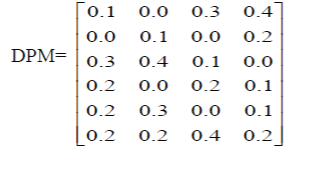 |
 |
| Table 3 shows the comparison of performance index of the system in the presence of both controllers. It can be observed from the table that the system with FCGA controller has less performance index than that of the system with integral controller which demonstrates the superiority of the FCGA controller. |
| Figure 3 shows the various frequency deviations and tie line power deviations in both the areas during a load change of 0.04p.u MW. It can be observed that FCGA is far superior than the integral controller in terms of peak time, overshoot and settling time in both the areas. In this work 3 Gencos in each area along with 2 Discos in each area have been considered. Figure 4 shows the generation of Gencos in area 1 and Figure 5 shows the generation of Gencos in area 2. |
| Figure 6 shows the comparison between the performance index of the system in presence of these controllers. It can be observed from the figure that the performance index of the system in the presence of FCGA controller is less than that of integral controller which indicates the superior working of the controller. |
CONCLUSION
|
| The performance of integral controller and FCGA controller for a two area hydrothermal system under restructured scenario has been investigated. It has been observed that the integral is capable of bringing better dynamic response of the system to some extent. But the conventional design approach requires a deep understanding of the system, exact mathematical models and precise numerical values. The basic feature of optimization technique like genetic algorithm is that it can be employed for tuning of gain of integral controller. In order to further improve the performance of genetic algorithm intelligent technique like fuzzy logic has been incorporated along with genetic algorithm. The simulation results show the superior performance of the system using FCGA controller |
APPENDIX
|
| R =2.4 Hz/p.u.MW; D = 8.33 10 3 ïÃâ¬Ã Ã¯Ãâô p.u. MW/Hz; Kg =1; |
| Tg =0.08 sec; Kt =1; Tt =0.3 sec; Kr =0.5; Tr =10 sec; |
| T1,T2 ,TR =41.6, 0.513, 5 sec; Tw =1 sec; K p =120 Hz/p.u. |
| MW ; Tp =:20 sec; B =0.425 p.u. MW/Hz |
ACKNOWLEDGEMENTS
|
| The author sincerely acknowledges the financial support provided by G.Pullaiah college of Engineering and Technology, Kurnool, Andhra Pradesh, India for carrying out the present work. |
Tables at a glance
|
|
|
Figures at a glance
|
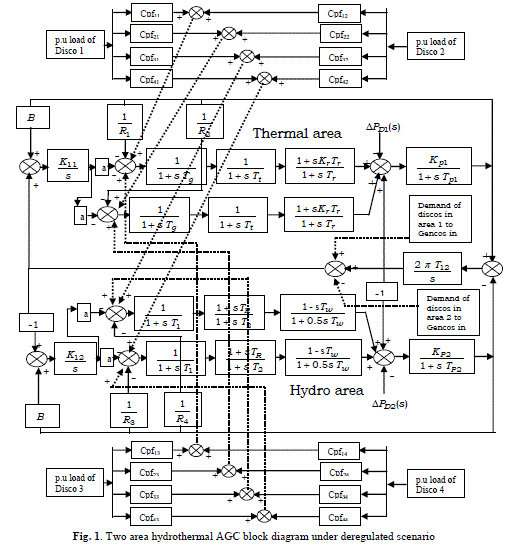 |
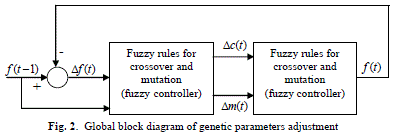 |
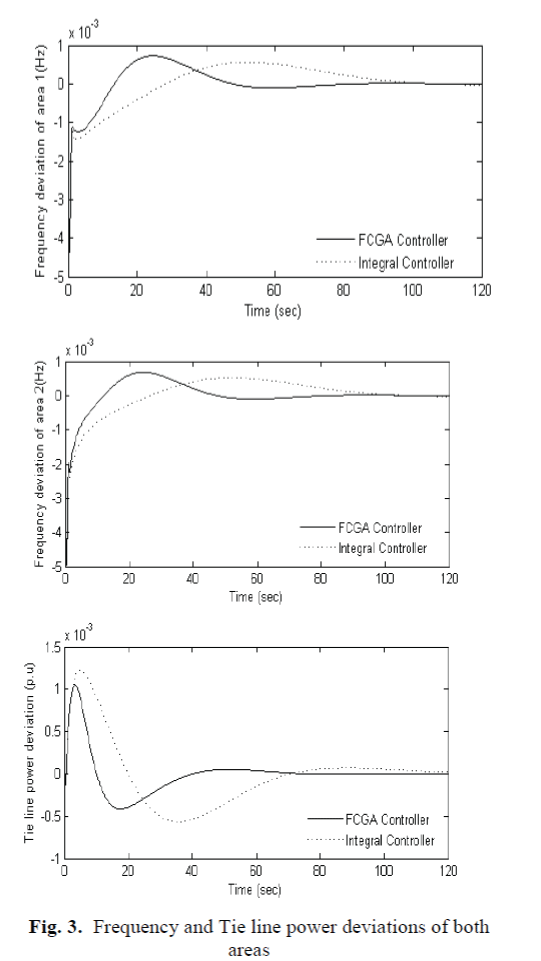 |
| Figure 1 |
Figure 2 |
Figure 3 |
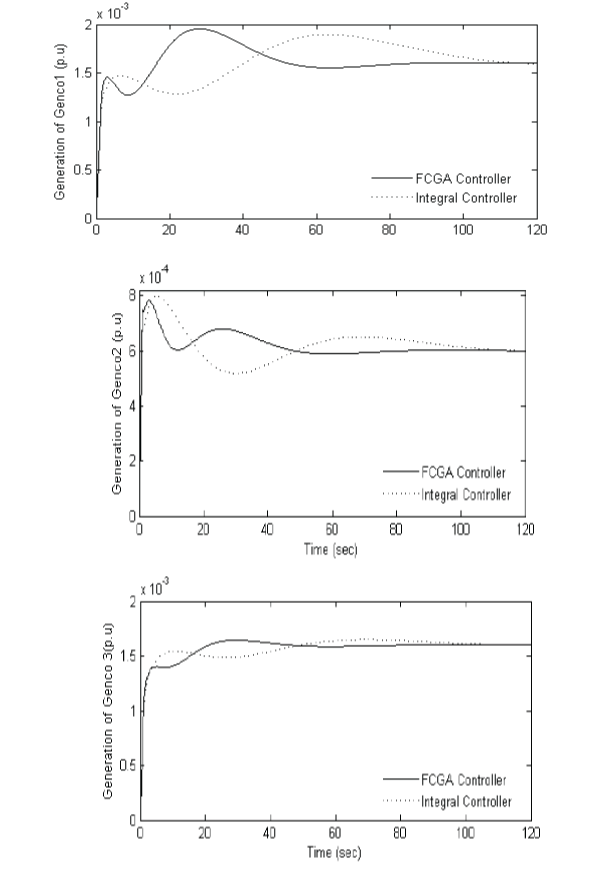 |
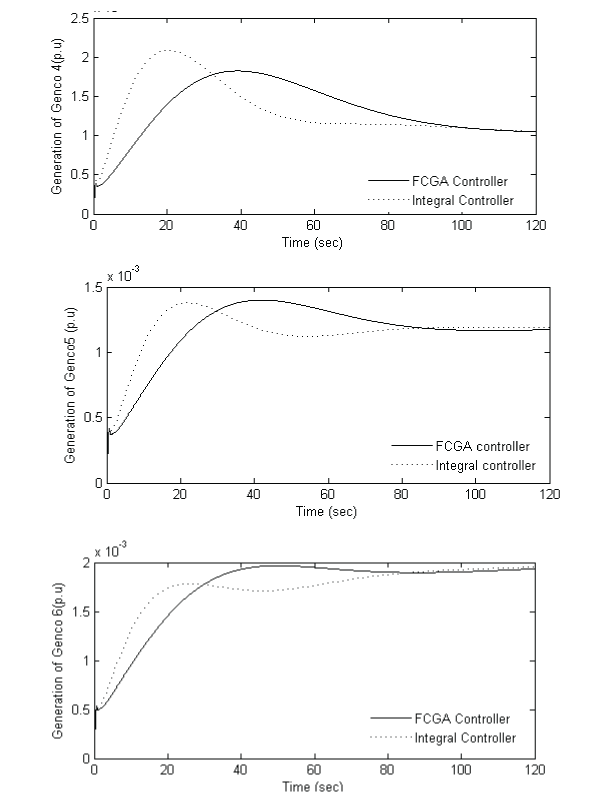 |
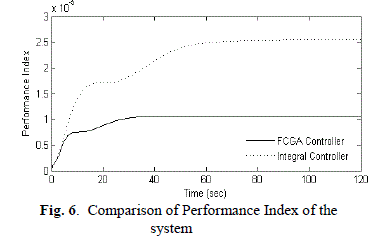 |
| Figure 4 |
Figure 5 |
Figure 6 |
|
References
|
- C. Concordia and L.K.Kirchmayer, Tie-Line Power and Frequency Control of Electric Power System - Part II, AIEE Transaction, vol. 73, Part- 111-A, pp. 133-146, April 1954.
- M.L.Kothari, B.L.Kaul and J.Nanda, Automatic Generation Control of Hydro-Thermal system”, journal of Institute of Engineers(India), vo1.61, pt EL2, pp85-91, Oct 1980.
- J.Nanda, M.L.Kothari, P.S.Satsangi, Automatic Generation Control of an Interconnected hydrothermal system in Continuous and Discrete modes considering Generation Rate Constraints, IEE Proc., vol. 130, pt D, No.1, pp 455- 460, Jan. 1983
- Schulte RP.Automatic generation control modification for present demands on interconnected power systems.IEEE Trans Power Syst1996:1286–91.
- Kumar J, Kah-Koeng Ng, Sheble G. AGC simulator for price based operation part 1. IEEE Trans Power Syst1997;12(2):527–32.
- Kumar J, Kah-Hoeng Ng, Sheble G. AGC simulator for price based operation part 2. IEEE Trans Power Syst1997;12(2):533–8.
- G.A. Chown and R.C.Hartman. Design and experience with a fuzzy logic controller for Automatic generation control, IEEE Transactionson power systems, Vol. 13 ,No. 3, pp.965- 970, August 1998
- Y.L.Karnavas and D.P. Papadopoulos, AGC for autonomous power system using combined intelligent techniques, Electric power systems research 2002(62),pp.225-239
- C.SrinivasaRao, S Siva Nagaraju, P SangameswaraRaju, “A Modified Genetic Approach to Hydrothermal System with ThyristorControlled Phase Shifter Under Open Market System” International Review of Electrical Engineering (I.R.E.E), Vol. 2, No. 4, Jul-Aug2007, pp. 507-514.
- David Goldberg.Genetic algorithms in search, optimization and machine learning.Addison-Wesley, 1989.
|